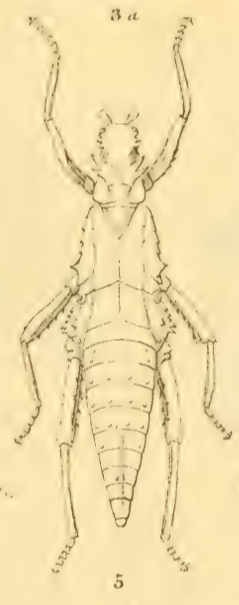Biology:Tisamenus cervicornis
| Tisamenus cervicornis | |
|---|---|

| |
| Tisamenus cervicornis, female from the first description by Bolívar | |
| Scientific classification | |
| Domain: | Eukaryota |
| Kingdom: | Animalia |
| Phylum: | Arthropoda |
| Class: | Insecta |
| Order: | Phasmatodea |
| Family: | Heteropterygidae |
| Subfamily: | Obriminae |
| Tribe: | Obrimini |
| Genus: | Tisamenus |
| Species: | T. cervicornis
|
| Binomial name | |
| Tisamenus cervicornis Bolívar, 1890
| |
| Synonyms[1] | |
| |
Tisamenus cervicornis is a stick insect species (Phasmatodea), in the family of the Heteropterygidae endemic to the Philippines island Luzon in the province of Camarines Sur.[1][2][3]
Description
So far only the two type specimens of this Tisamenus species are known. The female holotype is 48 millimetres (1.9 in) long. The male syntype is 35 millimetres (1.4 in) long. In Tisamenus cervicornis there are multitoothed postorbital crests on the head. Their second tooth is the largest. Behind the ridges sits a pair of conical tubercles. These features distinguish them from the similar Tisamenus armadillo and Tisamenus spadix. On the pronotum there are two strongly compressed, clearly bidentate combs that point obliquely backwards. The genus-typical triangle on the mesonotum is flatly concave as in Tisamenus spadix and Tisamenus tagalog and is only slightly longer than it is wide. It does not reach the middle of the mesonotum. The mesopleuras are toothed and have a spine above the mesocoxa. The expanded metapleurae are dentate, with the last two teeth being the larger ones. The second segment of the abdomen has an anterior and a posterior pair of tubercles on the upper side. On segments three to five there are four tubercles in the posterior area, one medial and one lateral pair. Only a pair of medial tubercles can be seen on the sixth segment.[2][3]
Taxonomy
Ignacio Bolívar described the species in 1890 under the current name. It depicts a female in top view and her ovipositor in detail from the side.[2] The female holotype and a male syntype are deposited in the Museo Nacional de Ciencias Naturales in Madrid. Both specimens are damaged, although the male is more severely damaged.[1] James Abram Garfield Rehn and his son John William Holman Rehn synonymized the genus Tisamenus with the genus Hoploclonia in 1939. At the same time, they divided the genus into different groups according to morphological aspects. In the so-called Deplanata group, they placed Hoploclonia cervicornis, with Hoploclonia deplanata (today Tisamenus deplanatus), Hoploclonia armadillo (today Tisamenus armadillo), Hoploclonia spadix (today Tisamenus spadix), Hoploclonia tagalog (today Tisamenus tagalog) and Hoploclonia fratercula (today Tisamenus fratercula), relatively unspined species, with a flat upper surface, which, apart from the supracoxal spines on the edges of the thorax, show no or hardly any spines, but at most teeth.[3] The original name was officially restored in 2004 by Oliver Zompro, who transferred or retransferred all Filipino species previously listed in Hoploclonia to the genus Tisamenus.[4]
References
- ↑ 1.0 1.1 1.2 Brock, P. D.; Büscher, T. H. & Baker, E. W. Phasmida Species File Online. Version 5.0. (accessdate 21 October 2023)
- ↑ 2.0 2.1 2.2 Ignacio Bolívar: Diagnosis de Ortopteros nuevos in Anales de la Sociedad Española de Historia Natural. 1890, Section 19, pp. 307–308 & plate 19, figure 5
- ↑ 3.0 3.1 3.2 Rehn, J. A. G. & Rehn, J. W. H. (1939). The Orthoptera of the Philippine Island, Part 1. – Phasmatidae; Obriminae, Proceedings of The Academy of Natural Sciences (Vol. 90, 1938), Philadelphia 1938/39, pp. 466–472
- ↑ Zompro, O. (2004). Revision of the genera of the Areolatae, including the status of Timema and Agathemera (Insecta, Phasmatodea), Goecke & Evers, Keltern-Weiler, pp. 206–207, ISBN 978-3-931374-39-6
External links
Wikidata ☰ Q10698648 entry
 |

